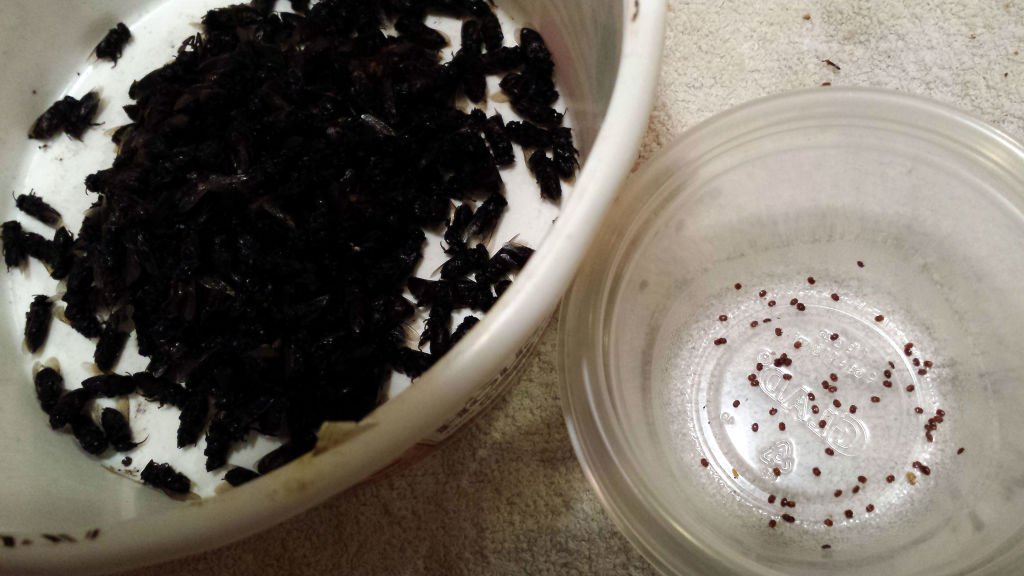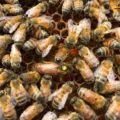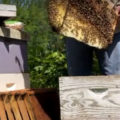I took advantage of the warm day on Saturday after a week of freezing temperatures to check on the beehives. It was a bitter-sweet day, because I have some hives that are really strong and looking good, but I lost two. It’s a sad sight for a beekeeper when one hive is bustling and the other has nothing happening.
I brought the two hives home and went through them. I broke them down and noted all the obvious things. How much honey, if any, was in it… was there any moisture on the lid? I then took two samples of bees from each hive and put them into a cup with 72% rubbing alcohol. I kept one sample for myself to do my own alcohol wash, and the other sample will be sent off to Beltsville Bee Lab Monday morning. (* Update, bee lab results are back, see them at the bottom of this post) I like to make sure my methods of measurement still come up with numbers that are similar to what I get back from a lab. Since I also can’t test for things like nosema, it just makes sense to me to send some out.

I ran my own tests tonight and, as I suspected, I’m going with varroa mites again. 7 mites per 100 on one hive and 4 per 100 on the other. It’s funny how you can have two hives right next to each other… seemingly identical in strength, using the same equipment and on the same forage, but each wildly different. The hive next to it is still very strong… in fact, opening the top of the hive, the numbers already show the queen has been laying, and new bees have emerged.
Broken down to its simplest form, we want to get the number of mites per 100 bees. I up my samples to take a ‘larger cross-section’ to 300 bees (about a half-cup of bees.) In this case, you would divide the result by 3 to get the number of mites per 100 bees.
If you are taking a sample of bees from your hive mid-season, you want nurse bees (shaken off a frame from the center of the brood) into a jar for testing. Make sure your queen is not in the sample. When mites emerge from a cell, they will either crawl into another cell to start the process over, or they will crawl on to the nearest bee and find a tender spot on them to suck on the bee’s hemolymph. Since the nurse bees are the ones that are taking care of the brood and usually always near the center of the brood nest, these are the bees that would most likely have the most mites on them. The final number is then doubled (to account for the mites that are still in the brood, and not on just the sample we took)
If you are processing a deadout (as I am in the pictures below) we are taking dead bees from wherever they are, but usually, there will be a big dead cluster of bees on the frames (frozen in time, see pics below). These bees are the better ones to sample than those laying on the bottom board. Of course, if you are doing a wash from a deadout (a hive that likely had no brood) then there would be no need to double the final number. So here is it, for those of you that Googled looking for the formula to process your data from an alcohol wash on your beehive:

If we took a 300 bee sample (about a half-cup) from a live colony during the season:
Number of mites ÷ 3 = Mites per 100 bees x 2 (to account for mites still in the brood) = Total mites per 100 bees in the hive
If we took a 300 bee sample (about a half-cup) from a deadout during the winter:
Number of mites ÷ 3 = Total mites per 100 bees in the hive (no need to double the result since there is no brood in a winter deadout. You will check your frames for brood, of course.)
Also, do not confuse adult bees that died head first in a cell with brood. Take into consideration what a high mite count is for you. That number is going to differ from one beekeeper to another based on the general strength of the hive, genetics of your stock and maybe even location. One of my mentors has bees that can tolerate a much higher mite load than I can. I am taking note of this kind of data so that I can understand over time what a high mite count is for my bees.
* Got the bee lab results back and our mite testing methods are solid! The results I came up with in my own alcohol wash correlate well with the results I got back. I was right. These hives were taken out by varroa. Now, we just need to get set up to check for nosema spores. See the picture below.

Click here to see a video of a deadout similar to the one that these bees were sampled from
View some pictures





















Does it concern you that your mite counts were roughly half the mite counts that the lab found?
Not really anymore. I was getting started with washes then. Now days, my counts are more in line with the labs. Just recently, I sent more samples to the lab after my own counts and they are much better.